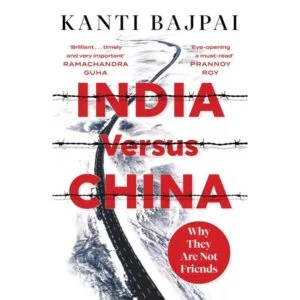India and China have been neighbours for thousands of years but differences keep arising and this is probably due to several factors. But as Professor Kanti Bajpai says on the opening pages of his latest book, India Versus China: Why They Are Not Friends: “India-China relations are darker and more complex than most observers appreciate or acknowledge”. He adds, “India and China are not friends for four key reasons”.
Bajpai says the two Asian giants don’t see eye-to-eye because of their “deep seated differences over their perceptions of each other”, “their territorial perimeters”, “their strategic partnerships” and “the asymmetry of power”. In Bajpai’s opinion, “mutual perceptions and the power asymmetry” are the most important. Professor Bajpai is Director, Centre on Asia and Globalisation and Wilmar Professor of Asian Studies at the National University of Singapore.
Participating in a discussion on his book with Prof Kishore Mahbubani, Distinguished Fellow and China scholar at the Asia Research Institute, National University of Singapore, Professor Bajpai said infrastructure development and Tibet are two critical issues underlying the ongoing faceoff between the two nations.
With China developing its infrastructure on the Tibetan side, it cannot see India catching up with it on this front and one of the major underlying causes of continuing border tensions is the rapid construction of border infrastructure like roads and airfields by India.
In this context, Bajpai made an interesting observation: “China has resolved its territorial quarrels with everyone else except India. Tibet is very vital for the Chinese as Greater Tibet is 40 per cent of China’s territory. Tibet is a massive issue with China.”
Bajpai observes that India and China’s mutual perceptions changed pretty significantly over the centuries. China looked up to Buddhist India; a millennium later, India held Imperial China in great regard. The situation changed from the 19th century onwards. China’s respect for India declined, if not withered away, whilst India began to see it through British eyes.
As Prof Mahbubani said, there is great support for the Dalai Lama in India but even he knows how important Tibet is to China and that is why he now talks of more autonomy for Tibet rather than an Independent Tibet. However, according to Prof Mahbubani, the most dangerous flashpoint in the world is Taiwan and China feels that the US is changing its line as the Joe Biden Administration has quietly turned away from the Trump policy and reverted to having unofficial ties with Taiwan.
On resolving the Sino-Indian border issue, Prof Mahbubani says that a swap is unlikely in the final agreement for the Chinese know that they will not get Arunachal and India knows that is the case with Aksai Chin. “What is missing is political will.” What angers China is that the Dalai Lama is being used as a political weapon by several western nations. “Tibet has become a source of distrust between India and China but Tibet can also be a point of friendship.”
Bajpai says that though there may be “sort of nice talk at the elite level, but there is casual racism on both sides. China considers itself to be at the Centre of the World and others are tributaries. China feels there is a great socialist revolution led by it and that India is a junior partner. China looks down on India and does not treat it as a great power.”
He said the Chinese term India as “chaotic where nothing gets done,” and as its Foreign Minister Wang Yi said it is a “tribal democracy”. During the 19th century China looked at India and Indians as not being strong and was contemptuous of Indian society, and it is a big challenge for India to correct these “perceptions”.
The concluding part of Bajpai’s book deals with the ever growing power disparity between India and China. “There is a massive power gap between the two countries and this massive power gap makes ties more difficult. This enormous gap in power has psychological and political consequences.”
Elaborating on this power gap, especially in the economic domain, Bajpai says the Chinese GDP is five times our size. The gap today between the Indian and Chinese economy is about $12 trillion.
He says if China and India were to grow at 6% each over the next 12 years— China, which has a GDP of $15 trillion today, roughly, will be at $30 trillion. India’s GDP is about $3 trillion today and in 12 years, it will double to $6 trillion. “That’s a $24 trillion gap. The gap between the two countries in absolute terms will double.”
Bajpai says it’s misleading to think about economic growth rates when the absolute gap is so massive. “In 1962, China was still a Communist country and India had a free market, but it was still outpacing us.”
He points out that this massive power gap means that the Chinese don’t see why they should concede anything to India because they are so powerful. On our side, we can’t dare make any concessions because it will be seen as surrendering to the Chinese.
Bajpai concluded by saying, “Neither side is able to or wants to make any concessions because it fears that would send the wrong signal. Unless India substantially closes this power gap, Beijing is not going to take us seriously and will continue to be bossy and unreasonable.”
– The writer is a senior journalist and media consultant. The views expressed are of the writer and do not necessarily reflect the views of Raksha Anirveda
– The writer is a senior journalist and media consultant. The views expressed are of the writer and do not necessarily reflect the views of Raksha Anirveda.






